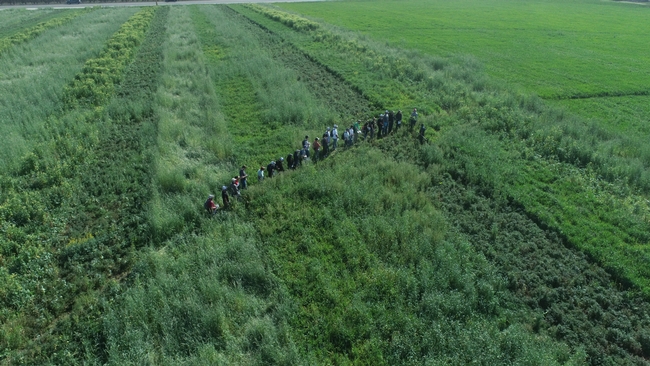March 4, 2022
Nearly 100 students in Dr. Anil Shrestha's weed science course at Fresno State University spent time in the field as part of their laboratory sessions to learn about the potential roles that cover crops and roller/crimpers might play in weed management and moreover, improved performance annual crop production paradigms. Although roller/crimpers have been around and used in several places around the world including the South American countries of Brazil, Argentina, and Paraguay, as well as in the Southeast US for decades, the technology is relatively new in California. However, Dr. Shrestha and his MS student, Robert Wilmott, have been evaluating the approach for five years on the CSU Fresno campus with good success and this spring their current study provided a very nice and rich educational opportunity for students to visit and observe.
During the week of February 28 through March 4, three lab sections of Dr. Shrestha's class toured the various cover crop mixes that he and Wilmott have in their study. The students learned about the background of the roller/crimper, its potential use in improved performance production systems that rely on principles of soil health management, and characteristics of the various cover crop treatments that Shrestha and Wilmott are evaluating as part of their ongoing study. Wilmott led each group of students out into the field where they observed the different cover crops and also learned about various weed species that were seen often in bare spots where the cover crops didn't cover the soil.
At the end of the lab, students helped Wilmott and Shrestha by collecting data on the maturity stages of two cover crops, Pacheco triticale and Merced rye, that are part of a multi-site evaluation of two maturity stages for cover crop rolling. Students took data on the percentage of random plants that were at the anthesis or initial flowering stage in the strips where replicated plantings of the two cover crop species were located. Rolling at antheis is one of the roller/crimper timing treatments that Shrestha and Wilmott and a wider group of colleagues in Salinas, Santa Cruz, and Davis are evaluating this spring.
A short video is available for viewing at You Tube describing the students' work in the field at
More background information on cover crop roller/crimpers is also available at the You Tube site
Attached Images:
